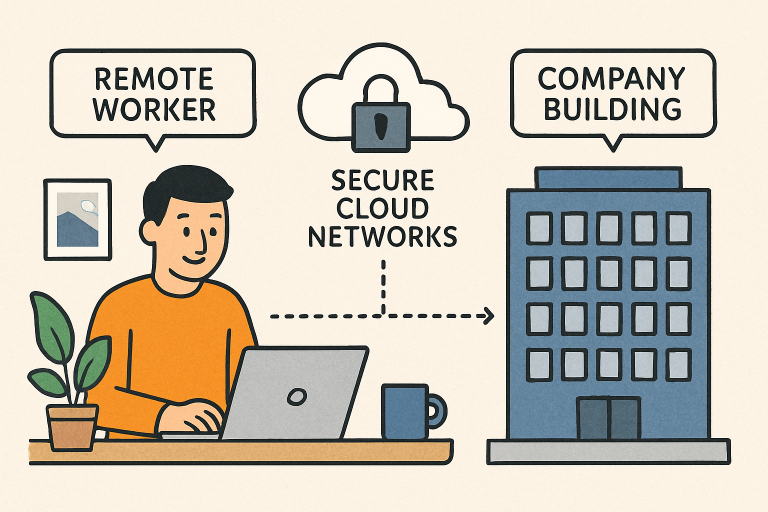The Rise of Remote Work and Its Challenges
The rapid adoption of remote work has redefined how businesses function, enabling flexibility and expanding the reach for skilled talent worldwide. However, this digital shift has presented IT leaders with new hurdles—chiefly, how to ensure network security and maintain productivity with a widely distributed workforce. Amid these concerns, businesses must rethink their strategy for securing employee access to corporate resources, as traditional perimeter-based defenses have proven insufficient. According to recent industry data, nearly every large organization—those with over 2,000 employees—reported experiencing some form of cyberattack in the last year. Notably, 44% of these attacks were directly linked to remote and hybrid work models, highlighting the elevated risk for companies without modern security architectures. In the wake of these challenges, many organizations are exploring next-generation frameworks, such as what is SASE?, to protect distributed operations and reinforce trust in remote work environments. As remote work persists beyond a temporary trend and becomes standard operating procedure for many industries, the necessity for robust, adaptive network security grows more urgent. Cybercriminals are increasingly targeting endpoints outside company firewalls, and remote access presents new points of vulnerability. IT teams are thus tasked with striking a delicate balance between ensuring tight security controls and minimizing disruption to end-user experience. With businesses relying so heavily on cloud apps, collaboration tools, and seamless data exchange, a centralized approach to security and network management simply no longer suffices. Instead, solutions must be agile, dynamically scalable, and simple to deploy across multiple geographies and device types to suit the diverse needs of a modern, mobile workforce.
Understanding SASE
Secure Access Service Edge (SASE) represents a paradigm shift in how corporate networks are constructed and defended. Introduced by Gartner, SASE merges wide-area networking (WAN) capabilities with comprehensive security functions—including secure web gateways, firewalls-as-a-service, and zero trust network access—all delivered via the cloud. This unified architecture moves enforcement points closer to users, wherever they are, making security both more consistent and context-aware. SASE extends beyond simply safeguarding remote connections; it reimagines network design by integrating networking and security into one seamless, cloud-delivered offering. Every user, regardless of device or location, is subject to uniform policy enforcement. In practice, this enables organizations to uphold compliance standards and minimize risk, even as employees roam between home, branch offices, and public networks.
Enhancing Security in a Distributed Workforce
In the context of remote work, legacy security models built on the idea of a controlled office perimeter are quickly becoming obsolete. SASE embraces the concept of zero trust—never assuming inherent trust based on network location. Instead, it mandates identity and device verification for every access request, continuously evaluating trust even after initial authentication. This granular approach to access control significantly narrows the potential pathways available to attackers. If a user or device shows signs of compromise or deviates from normal behavior, SASE solutions can automatically revoke access, thus isolating threats before they move laterally across an organization. Combined with advanced threat intelligence, this helps enterprises protect sensitive data against ransomware, phishing, and insider attacks, no matter where their teams are located.
Improving Performance and User Experience
While security is paramount, remote employees also expect fast, reliable access to their tools and documents. SASE optimizes performance with a globally distributed infrastructure of Points of Presence (PoPs), intelligently routing data to minimize latency. Unlike legacy architectures that funnel traffic back to centralized datacenters, SASE allows users to connect directly to cloud services—substantially reducing slowdowns and bandwidth congestion. This direct-to-cloud approach leads to measurable productivity gains. Recent case studies have shown that SASE adopters often see a 20–30% improvement in application speeds, greatly enhancing user satisfaction and enabling seamless collaboration across departments. For IT leaders, these advancements promise not just smoother workflows but also fewer support tickets and performance complaints.
Simplifying Network Management
SASE’s unified, cloud-managed platform dramatically simplifies the work of IT and security teams. Administrators no longer need to juggle disparate consoles for different security layers or networking components. With centralized visibility, IT can enforce policies, monitor real-time activity, respond to threats, and apply updates globally from a single dashboard. This streamlined approach to management reduces training costs, operational overhead, and the risk of configuration errors. It empowers lean IT teams to deliver enterprise-grade support and security at scale, which is particularly valuable for organizations undergoing rapid expansion or integrating remote-first operating models.
Real-World Impact of SASE Adoption
Deploying SASE has delivered significant, quantifiable improvements for organizations across industries. Beyond bolstering cyber defense—blocking billions of malware and phishing attempts annually—companies have reported noticeable acceleration in cloud application performance and reduction in support overhead. Employees gain uninterrupted access to mission-critical resources, while security postures remain robust and adaptive to changing threats. Businesses transitioning to SASE frameworks experienced fewer breaches, improved audit compliance, and greater resilience against emerging cyber risks. As a result, SASE is rapidly becoming a key enabler for digital transformation initiatives.
Future Directions of SASE
The next phase of SASE will build on current successes by incorporating advanced technologies such as artificial intelligence (AI), machine learning, and integration with 5G networks. Automation powered by AI will revolutionize threat detection and response, allowing security policies to self-adjust in real time based on evolving risk patterns. Meanwhile, 5G will deliver the ultra-low latency and high capacity needed to support emerging business applications and richer collaboration experiences. As SASE matures, its adaptability and scalability will position it as a foundational component of the modern digital enterprise—capable of protecting users and data wherever business happens.
Conclusion
The rapid evolution of remote work demands a new approach to network security and connectivity. SASE empowers organizations to meet this challenge head-on, unifying security, networking, and policy enforcement in a scalable, cloud-delivered solution. By enhancing security, streamlining management, and improving employee experience, SASE is not just addressing today’s challenges—it is paving the way for a more secure, flexible future of work.
